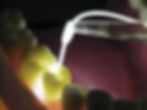
Diagnostic measures in minimal intervention dentistry (MID)
Sep 15, 2024
3 min read
9
41
0
The recognition and early diagnosis of caries are fundamental in minimal intervention dentistry, emphasizing the shift towards nonsurgical treatment approaches. Historically, dental caries were diagnosed using a dental probe and X-ray machines. Although X-rays, especially bitewing radiographs, remain reliable for detecting proximal caries, they are less effective for shallow occlusal caries located in the outer third of the enamel (Angnes et al., 2005). To address this, new technologies have been developed to complement traditional diagnostic tools.

Key Diagnostic Devices:
Fiber-Optic Trans-Illumination (FOTI):FOTI uses high-intensity light to penetrate the tooth, enabling the identification of different tissue densities. While FOTI is effective in detecting occlusal and buccal caries, it is less sensitive for detecting small proximal caries compared to bitewing radiography (Rochlen et al., 2011).

Laser Fluorescence (DIAGNOdent):This device uses a 655 nm wavelength of monochromatic light to excite bacterial protoporphyrin, resulting in fluorescence. The degree of fluorescence correlates with the presence and severity of a carious lesion. However, readings may be affected by restorative materials, stains, or discolorations on the tooth (Lussi et al., 2001).

Quantitative Light Fluorescence (QLF): QLF uses specific wavelengths to induce fluorescence in dentin, and digital imaging software quantifies the loss of fluorescence, helping to monitor caries progression. However, QLF is limited to accessible surfaces and is complex, making it uncommon in private practice (Stookey et al., 2005).

Tri Plaque Gel/Disclosing Agents: These agents reveal different plaque stages—thin, mature, and cariogenic—through various color tones. This tool is particularly helpful for motivating patients by visually showing areas missed during oral hygiene (Walsh et al., 2013).
Visual-Tactile Methods: Due to the lack of consistency and validation in advanced caries detection devices, the visual-tactile method remains essential. It aligns with the modern approach of minimal intervention dentistry (MID), moving away from the surgical classifications of G.V. Black. New caries indices, such as Mount and Hume and the International Caries Detection and Assessment System (ICDAS), now include enamel lesions (Frencken et al., 2012).
Caries Risk Assessment (CRA):
Caries risk is defined as the likelihood of developing future caries and forms the basis of patient-specific oral health management plans. However, the assessment is challenging due to its dynamic nature, and CRA provides only a snapshot of risk at a particular moment. Harris et al. (2004) emphasized that a patient’s past and present caries experience remains the most accurate predictor of future caries development.
In conclusion, although various diagnostic devices and methods have been developed, there remains a lack of consistency and validation in their sensitivity and specificity (Gomez et al., 2013). Despite technological advances, traditional methods, like visual-tactile inspection and caries risk assessment, continue to play a significant role in modern dentistry.
References:
Angnes et al., 2005: Discussed in the context of the clinical effectiveness of laser fluorescence, visual inspection, and radiography in detecting occlusal caries.Citation: Angnes, V., Angnes, G., Batisttella, M., Grande, R.H.M., Loguercio, A.D. and Reis, A.(2005). Clinical effectiveness of laser fluorescence, visual inspection and radiography in the detection of occlusal caries. Caries Research, 39(6), pp.490-495.
Rochlen and Wolff, 2011: Mentioned in relation to technological advances in caries diagnosis, such as FOTI and DIAGNOdent.Citation: Rochlen, G.K. and Wolff, M.S. (2011). Technological advances in caries diagnosis. Dental Clinics, 55(3), pp.441-453.
Lussi et al., 2001: Referenced when discussing the performance of a laser fluorescence device for detecting occlusal caries.Citation: Lussi, A., Megert, B., Longbottom, C., Reich, E. and Francescut, P. (2001). Clinical performance of a laser fluorescence device for detection of occlusal caries lesions. European journal of oral sciences, 109(1), pp.14-19.
Stookey, 2005: Related to the limitations of Quantitative Light Fluorescence (QLF) for caries detection.Citation: Stookey, G.K. (2005). Quantitative light fluorescence: a technology for early monitoring of the caries process. Dental Clinics, 49(4), pp.753-770.
Gomez et al., 2013: Addressed in relation to the sensitivity and specificity controversies of diagnostic devices for non-cavitated lesions.Citation: Gomez, J., Tellez, M., Pretty, I. A., Ellwood, R. P., & Ismail, A. I. (2013). Non‐cavitated carious lesions detection methods: a systematic review. Community Dentistry and Oral Epidemiology, 41(1), 55-66.
Walsh and Brostek, 2013: Discussed in the context of Tri Plaque Gel and its use as a disclosing agent.Citation: Walsh, L. J., & Brostek, A. M. (2013). Minimum intervention dentistry principles and objectives. Australian dental journal, 58, 3-16.
Frencken et al., 2012: Referenced when explaining Visual-Tactile methods and Caries Risk Assessment.Citation: Frencken, J. E., Peters, M. C., Manton, D. J., Leal, S. C., Gordan, V. V., & Eden, E. (2012). Minimal intervention dentistry for managing dental caries–a review: report of a FDI task group. International dental journal, 62(5), 223-243.
Harris et al., 2004: Mentioned regarding caries risk factors and risk prediction in young children.Citation: Harris, R., Nicoll, A.D., Adair, P.M. and Pine, C.M. (2004). Risk factors for dental caries in young children: a systematic review of the literature. Community dental health, 21(1), pp.71-85.













